May the Kairos Be with You: accessibility, authdi, veils and star wars
Yoda shoulda said
May the kairos be with you.
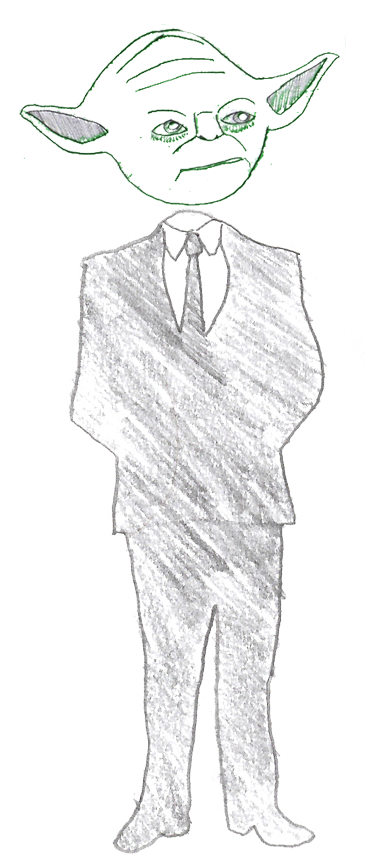
Kinneavy shoulda said

Thekairos gives a Rheti power.
We say

Jedis use the Force to anticipate and respond to the world around them in ways similar to rhetors using kairos to enhance the persuasive power of texts.
The Force—like kairos—means using it propitiously (i.e. in due measure) at the “right” time and in the “right” place.
Mobile and social media technologies have evolved a new form of kairos: #kairos—the way in which kairos has become omnipresent and omniplace or “Forceful” and very like Star Wars's Force.
Just imagine using kairos here instead of the Force. we think it works. go rhetoric!


Harker says kairos looks like this:
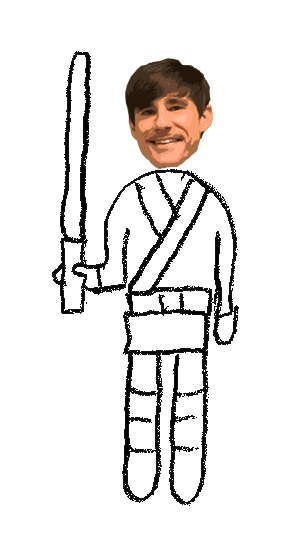
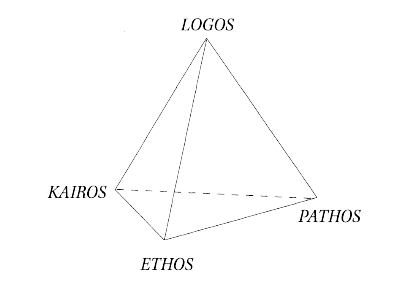
So we say say kairos looks like this:
Unlike Harker’s visualization of kairos in which kairos seems isolated, static, and prescribed, kairos has become an everytime in an everyspace, accessible beyond privileged Jedis who were the only ones able to tap into the “Jedi Network System” (JNS). Kairotic opportunities, in other words and like the Force, are now everywhere and everytime.
Rather than thinking of kairos as a discrete entity, think of it more like this: “The Force [kairos] is what gives a Jedi his power. It's an energy field created by all living things. It surrounds us and penetrates us. It binds the galaxy together.” In other words, kairos is the where and when a Rheti logoses, ethoses, and pathoses around.
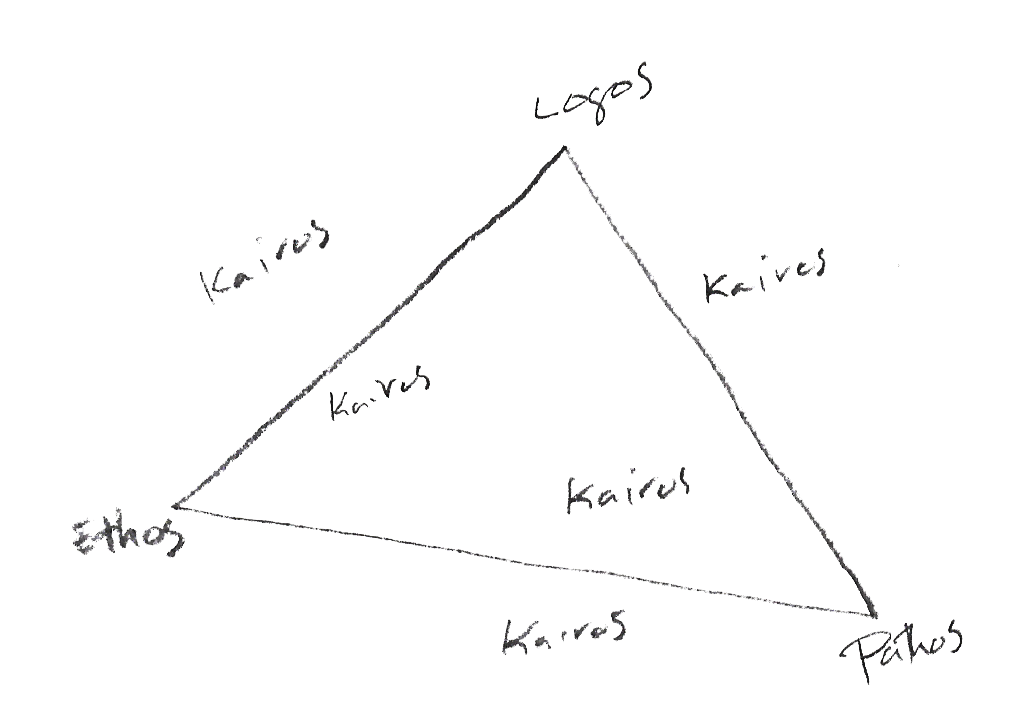

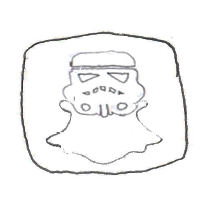

 Perhaps, we are being a little dramatic. It isn’t as though using #kairos will result in Jedi-like telekinetic or precognitive abilities. Paying attention to the power of #kairos, however, can have profound effects on the ways rhetors engage with and understand communication and harness its “Force” or power. In what follows we ask you to “learn the ways of the #kairos” and enjoy our troping around kairotically with Star Wars as a way to describe and communicate the significance of #kairos in our current techno-rhetorical moment.
Perhaps, we are being a little dramatic. It isn’t as though using #kairos will result in Jedi-like telekinetic or precognitive abilities. Paying attention to the power of #kairos, however, can have profound effects on the ways rhetors engage with and understand communication and harness its “Force” or power. In what follows we ask you to “learn the ways of the #kairos” and enjoy our troping around kairotically with Star Wars as a way to describe and communicate the significance of #kairos in our current techno-rhetorical moment.
The Forccce
Episode I: A New Kairos


The way we communicate today is altering the way people pay attention—which means we need to explore and understand how to train attention now, so that we, not our devices, control the shape of this alteration in the future (Rheti Rheingold 14–15).

We feel ya, Rheti Rheingold.
Your theory applies to the Jedi. Jedi (Rheti) training is connected to Kairos training. Training attention means training one to be kairotic—to use the Force propitiously in the right time and place.

You know, feel those midiclorians, learn to trust those instincts, focus your attention, and make your next rhetorical move and be propitious in space and time. All that advice is pretty good. It’s about understanding kairos and being a good Rheti.
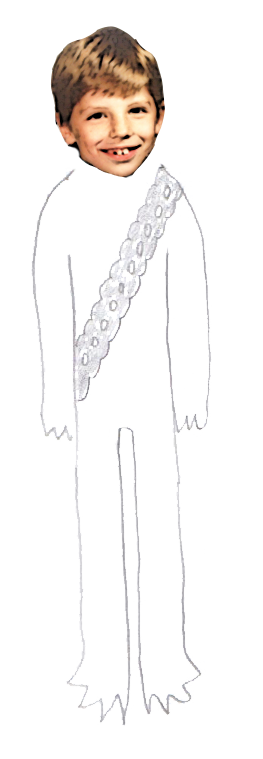
It's helpful to think about kairos in two ways.
invented kairos
A term for creating “propitious” or “right” time and “right” space for communication.
(hover for video transcript)
It’s when we create a website, a Twitter, a FB, a Tumblr, a Pinterest, for the Muhlhauser or Blouke or Schafer brand—we create opportunities for kairos, to be timely, to be become part of a medium, begin communicating.
situated kairos
Pre-existing times and spaces for “right” or “propitious” communication.
tbt situated kairos
It's when we follow the cultures of use in social media—"The conventions, norms and values for using a particular tool that grow up among a particular group of users" (Jones and Hafner 193).
well, so what?
It's the economy, Jar Jar! The ATTENTION economy. Value in the attention economy is dependent on #kairos, and wealth can be built in this economy by utilizing situated and invented kairos thoughtfully. In digital spaces users are asked to give their attention to numerous sources, but only some of these bids result in a transaction. Maximizing a rhetor’s effectiveness through awareness of various forms of time and place—in online and digital spaces—means that we’re engaging in an attention economy that depends on kairos. We see, therefore, online and digital spaces as existing within a #Kairos Economy.

The Forccce
Episode II: Accessibility of the Clones

We believe in the power of accessibility
Online, accessibility “means that people with disabilites can use the Web. More specifically, Web accessibility means that people with disabilities can perceive, understand, navigate, and interact with the Web, and that they can contribute to the Web” (“Introduction to Accessibility”).


it's ethical
A Rheti shows he/she cares about and is willing to accomodate audiences with diverse abilities and needs.
it's #kairotic
A Rheti is providing more opportunities to be every right place and every right time for audiences.

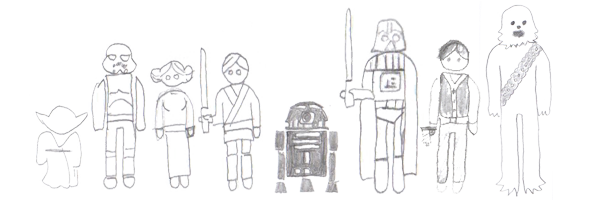

#kairos accessibility is more than that
It's also about taking advantage of the web's affordances and accommodating audiences' varied literacies, languages, reading practices, preferences, locations in space and time, desires, and motivations.

Be fluent in 6,000,000 forms of communication
Or, do what you can and present ideas in:
- multiple ways (like an infographic and a "traditional" academic essay)
- multiple languages and for multiple devices (i.e. smart phones, desktop, pads)
- share ideas in multiple places at multiple times (i.e. Facebook, Twitter, or Instagram before, during, and after "The Force Awakens" or any other Star Wars film or event)

it's ethical
A Rheti shows he/she cares about and is willing to accomodate audiences with diverse abilities and needs.
it's #kairotic
A Rheti is providing more opportunities to be every right place and every right time for audiences.

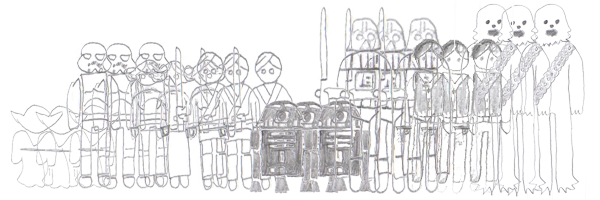


This kind of accessibility may take more knowledge and skill of different genres and technologies to create. However, these moves are worth it - they are #kairotic and ethical. By composing in multiple formats, a Rheti is being more cooperative with readers/audiences rather than being directive or prescriptive. Audience members are not clones of each other. Besides physiological differences, audience members have literacy differences. They are part of different discourse communities in which words have different connotations and denotations. For instance, “a tremor in the Force” means one thing to a Jedi and something quite different to a physicist (a related vein). And while we agree with the reasons to make web content accessible technically, we also feel there is a #kairotic benefit and ethic for accommodating readers and creating texts that are truly texts in the plural that pay attention to the accessibility of different literacies.
The Forccce
Episode III: Return of the Authdi
Authdi is our term for participants in a #kairos economy
It's author + audience (yup, rhymes with Jedi)—is a different lens for taking into account the “new” relationship we have with authorship in digital media environments and observing how boundaries between the binaries of being an author and being an audience are blurring. And it's not like we didn't do it before there was digital media. Now it's easier to be authdi's who put things in a tangible form—see?

I'd authdi
by remixing Star Wars with The Snorks. My Boba Fet action figure married a Snork.
Now I tweet and retweet.

I'd authdi
by remixing Star Wars with My Little Pony and Care Bears. Han Solo ran a veterinary clinic.
Now I remix media and comment on remixes.

I'd authdi
by remixing Star Wars' X-Wing fighter and crash landing in Hot Wheels traffic.
Now I write articles on health issues.

Instead of “produsers” or “prosumers” we like authdience
We don’t think those terms explain exactly what we do when we watch, comment, and play with Star Wars in a #kairos economy where opportunities for being propitious in times and places are omnipresent and omniplace[nt].

Produser blurs the line between PROFESSIONAL and AMATEUR.
Prosumer blurs the line between CONSUMPTION and PRODUCITON.
Neither help us blur the line between AUTHOR and AUDIENCE.
Authors and audiences are more like curators and remixers of texts than “original” or “authentic” creators. Bahktin might put it like this: “Language has been completely taken over, shot through with intentions and accents…. Each word tastes of the context and contexts in which it has lived its socially charged life” (Bahktin qtd. in Jenkins 224). As Jenkins explains, “The finished text, then, (following its original meaning as something that has been woven together) represents an attempt to coordinate the diverse materials the writer has appropriated, to evoke or to erase previous meanings, to bestow coherence and consistency” (224). Authors, then, read to remix or weave.
whatta weave!
If a major goal of authdi is to enact change, get a message out, and connect with other authdis, then #kairos is vital. Rheti Rheingold makes the important point that “In previous eras, it may have been true that ‘it’s not what you know but who you know.’ Today, how you know who you know matters as much as who you know, and one of the most valuable traits a person could have in a twenty-first-century organization is a knack for knowing “who knows who knows what” (24). And, for us, with the amount of information vying for authdience attention, it’s really “who knows who knows what, where, and when.” It’s really about knowing how to be propitious during a time and a place.

The Forccce
Episode IV: The Phantom Veils
learn veilling for success in a #kairos economy
Rheti Rheingold’s point about a knack for knowing is connected to veils too. Because there is so much accessible information being produced in the digital realm, it becomes more important to know “who knows.” The “who’s who knower” or the person that knows knowers is in a sense a person who is relied on for kairos—for knowing what (or who) might be valuable at a time and in a place. So for us, as we previously mentioned, it’s really “who knows who knows what, where, and when.” It’s really about knowing how to be propitious during a time and a place. So there really is a knack for knowing when to know when to know what & where to know where to know what. Yoda, did we imitate just? Using veillances is a lens for sorting the “who’s who knowers” in a #kairos economy.

Got #FoMO?
We do and so do the Jedi. #FoMO is really a kairotic problem. It's a fear of missing #kairos or acting akairotically that happens when we aren't veilling well.
(hover for video transcript) (hover for video transcript)the veils
* Veillances aren’t on solid ground. Authdi shift between veils depending on how they may perceive themselves and their relation to others. And, depending on your point of view, one person's constraint might be another person's light saber—affordance.
surveillance
The veillance of an authority or power is “Observation or recording by an entity in a position of power or authority over the subject of the veillance” (Mann).
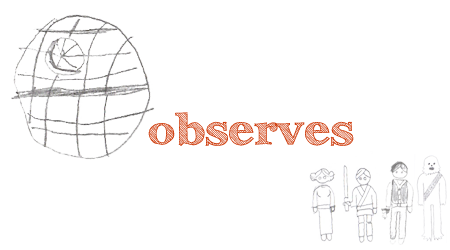

examples

- Jedis surveying the feelings of those who aren’t Jedi or don’t have Jedi powers.
- Teachers assessing student work (tests, essays, homework, etc.).
- Using an education platform’s—like Blackboard—metrics to see who’s accessing Blackboard, how and when.
- Companies, governments, individuals using website analytics (Google Analytics, Facebook’s Page analytics, Twitter analytics, Pew Internet Analytics, or demographic apps like Hootsuite’s Demographics Pro, Alexa) to sort and categorize visitors as types of consumers or citizens.
- Companies, governments, or individuals in a position of authority reading and evaluating web comments on a product, idea, blog, etc.
affordances
- Allows authority to see what information is being viewed and responded to in terms of clicks, views, likes, people reached, and comments. Sorting and evaluating such information can be valuable in creating persuasive texts—i.e. style, delivery, arrangement, timing, and content—and includes collecting knowledge related to the metrics of what gets clicks and what gets read on the internet.
- Allows authority to profile and sort individuals and make kairotic predictions about behavior. Sorting and predicting can include original posts, but information such as who connects, likes, retweets, or otherwise participates in forms of viralization and information-sharing, can be surveilled as well.
- Enables authority to maintain reputation and remain an authority by allowing authorities to survey and respond to criticisms and/or misunderstandings.
constraints
- Ethical considerations have to be acknowledged because surveillance allows authority to profile and sort individuals and make predictions about behavior, which can lead to stereotyping and, possibly, erroneous or dangerous assumptions about people.
- The amount of data collected may make it difficult to tease out “knowledge” or meaning from noise.
- Allows authority to make unfair judgments on the reputation of individuals.e
- May result in repetition where style, delivery, arrangement, timing, and content become mundane. Informed “clickbait” stops working because of tunnel vision guided by big data.
- What gets clicked or read isn’t necessarily quality content and may assume a more or less source-savvy audience.
sousveillance
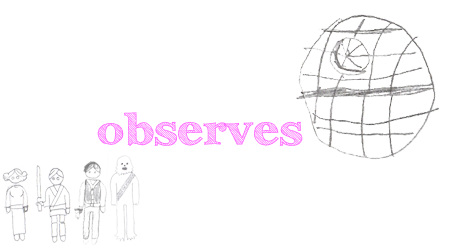

Sousveillance is the “Observation or recording by an entity not in a position of power or authority over the subject of the veillance” (Mann).
examples
Check out the kosmos web series for an exciting and intriguing take on the relationship between sousveillance and surveillance. The creators have coined the term “crowdviewing” to ![]() describe how the audience is responsible for “unlocking” episodes. The audience monitors the site along with the authors and helps distribute the content explicitly.
describe how the audience is responsible for “unlocking” episodes. The audience monitors the site along with the authors and helps distribute the content explicitly.
Check Collusion for a demonstration of website tracking and use ![]() Mozilla's Lightbeam add-on to watch the watchers web tracking you.
Mozilla's Lightbeam add-on to watch the watchers web tracking you.

- Princess Leia sousveying the Deathstar in order to obtain information that will destroy it.
- Students assessing their instructors or school in evaluations.
- Curating authority figures and/or experts in Twitter lists, following, and learning from these experts or authority figures.
- Becoming friends with authority figures in a field and “Liking” or reviewing comments and commenting on Facebook profiles and pages.
- Commenting on a product, place, or service on Amazon, Yelp, or Angie’s List.
- Monitoring what the surveyors are collecting.
affordances
- Enables one to get a bead on authority and reputation of surveyors. By watching the watchers, one can get a sense of who knows who knows what.
- Enables for curation of experts and analysis of what’s successful to those in power (e.g. experts in the field) and determine what’s current and what’s relevant in a discussion.
- Provides opportunity for authdi to observe authority to ascertain holes, niches, angles, that haven’t been discovered so that he/she might develop an authority and reputation of his/her own and experiment with style, delivery, arrangement, timing, and content. This creates a sort of surveillance-sousveillance feedback loop.
- Allows sousveyers to voice opinion, review, and possibly enhance reputation through contact with a surveyor.
constraints
- It may not be possible to know everything that’s been collected about oneself or how it’s being done and, for many people, it isn't possible to authdi algorithms that generate one's own metrics.
- Surveyors have power over sousveyors, and comments or critiques by souveyors may be ignored, deleted/silenced, or, in worst case scenarios, used to damage their reputations or ability to communicate (example: Facebook deleting accounts).
coveillance
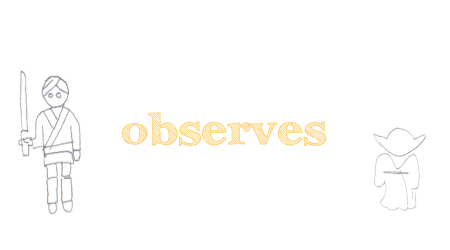

Coveillance is “peer to peer” and occurs when “ordinary citizens engage in [monitoring] practices” on one another (Rainie and Wellman). Being a coveyor is important for observing what those around you are doing.
examples

- Jedis feeling each others’ Forces (There's gotta be a better way to put this).
- Students or instructors providing feedback to each other informally. ***The formal transforms this into surveillance (where consequences of feedback is a metric for grades, raises, tenure etc.).
- Twitter backchannel conversations during a presentation by authdience members or those following the hashtag conversation.
- Reading and evaluating comments, favorites, likes, and ratings of products or peer posts by “regular” people on Amazon, Angie’s List, and Yelp.
- Watching Facebook Messenger and interpreting the meaning of the response time of knowing that the person you messaged has in fact seen your message.
- Watching the “Activity” section of a co-written Google Doc and assessing who is participating and how much and is it on time and determining if it’s “time” for you to participate more.
affordances
- Observe how peers are responding to authority in comments and ratings to make informed decisions. Monitoring what they are clicking, retweeting, sharing, and liking.
- Learn about peers’ research, politics, etc. and locate colleagues, partners, and other authdi for networking.
- From our experience, coveillance often results in what might be called “variety learning” where perspectives and information from alternative positions and surveyors can be discovered.
constraints
- Peer comments may be limited or biased, especially if the sample is small. It may be difficult to find a more balanced perspective.
- Can limit perspective by enabling one to generate his/her own filter bubble or algorithm in which authdience is not seeing varied perspectives on issues.
selfveillance
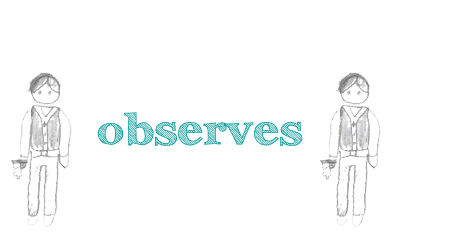

Selfveillance is a term coined by one of Paul’s new media writing students (Baumgardner). It refers to a meta-type of observation in which a person observes him/herself as an authdience.
examples

- When Luke searches his feelings and evaluates himself and his connection to the Force.
- When instructors evaluate their evaluations.
- When individuals search back on Facebook timelines or Twitter feeds and evaluate their own posts and feedback they’ve received.
- Using a FitBit or Apple Watch or other such gizmo to monitor movement or heart-rate and making behavior adjustments based on the reading.
- Googling oneself and examining one’s digital footprint, reputation, and the news one is filtered. This might also be considered a form of sousveillance; however, because it is directed at oneself and not outward—where one might sousvey what Google collects in general—we’re putting it here. Selfveillance is specifically about monitoring one’s own online behavior and its interpretation.
affordances
- Allows one to monitor and evaluate one’s own digital footprint and reputation.
- Allows one to make a sort of reputation plan—a plan that helps move the good information to the top of search engine hits and the less pertinent or “bad” information to the bottom by adding positive content and/or deleting negative content.
- Content is remembered. There is a growing history of one’s successes and failures at communication.
constraints
- It is difficult and in some cases it may be impossible to delete slander or “bad” information since data miners (including popular social media platforms like Facebook) may never completely delete a post or a browser trail you’ve been on.
- As mentioned in “affordances,” content is remembered. There is a growing history of one’s successes and failures at communication.
- Because of how content may be remembered and changed, selfveillance might gaslight your own memory where you remember more synecdochally (more parts for whole or whole for parts). Go to “ "Like Me, Like Me Not" and click on the read petal for more about gasligting and the web
 For us, it’s important to examine the rhetoric of different power positions afforded by veil analysis. Such analysis offers unique perspectives on communication and helps us understand how we may use a different communication strategy depending on this position. This is our introduction to this sort of analysis and we hope it inspires others to continue developing our ideas for increased rhetorical awareness and rhetorical practice.
For us, it’s important to examine the rhetoric of different power positions afforded by veil analysis. Such analysis offers unique perspectives on communication and helps us understand how we may use a different communication strategy depending on this position. This is our introduction to this sort of analysis and we hope it inspires others to continue developing our ideas for increased rhetorical awareness and rhetorical practice.
The Forccce
The #kairos awakens
#kairos shares a lot of similarties with the Force but...

the analogy, thankfully, breaks down. As geeky and cool as it would be to have Jedi abilities (magical clairvoyance and telekinesis), we're happy to awaken kairos and leave the Force on the screen in the Star Wars universe.

we don't like that the Force is part of an elite Jedi club
Unlike with a #kairos economy, you can’t really join the club through research, practice, becoming an authdience, becoming a curator, and knowing who knows who knows what. Even special toothpaste won't help.


we don't like that the Force has one search engine
The Jedi only use one search engine, one data collector, an algorithm, and/or one social media platform—the Force. We mean the Force seems to be pretty biased doncha think? How can one #kairos when the possibilities of surveillance, sousveillance, coveillance, and even selfveillance are limited to one “technology.” So the Force is sort of an ultimate filter bubble.
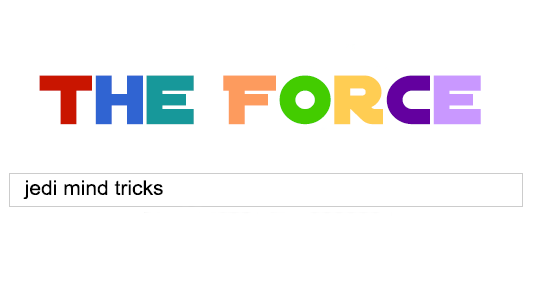
we don't like that the Force is deterministic
We believe in authdiencing and the power of being a rhetor operating within constraints—be they the constraints of the Force, the media platform, or the veil. An authdi has agency both as an author and an audience to transform texts and make decisions about how to use information. Han Solo summarizes our belief well.
(hover for video transcript)

We think
- We think it is important to think of ourselves as being in a #karios economy.
- We think this is important because with all the information out there, rhetors need to be aware of when and where to be timely and placely to get their message out and to participate in a medium. Though a little dramatic, #karios is a way to think about Rheti Jenkin’s aphorism about media: If it doesn't spread, it's dead. And, again, to spread and live is to pay attention to #kairos, displaying a what at an important when and where.
- We think examining veillances in a variety of forms can be good tools, lenses, “HO HO HO—Jedi mind tricks,” for living in an economy based on #kairos and considering the ethical dimensions of using these tools—i.e. how they work with other economies like the emerging attention (Lanham) and reputation economies (Fertik and Thompson).
- We think this is important because it helps us use, see, and examine the Force that is social media.
- We think it is important because it isn’t necessarily elite, we can see more varied perspectives, and, well, it may help us better imagine what it means to be an authdi.

So keep your smartphones by your side. These are the weapons of ominpresence and omniplaceness; these are the weapons of the authdi knight.
May the #kairos be with you!
The Forccce
Credits
Mainly Linguistic Text
Baumgardner, Amy. “Selfveillance.” Class discussion. Fall 2013.
Fertik, Michael, and David Thompson. The Reputation Economy : How To Optimise Your Digital Footprint In A World Where Your Reputation Is Your Most Valuable Asset. New York: Crown Business, 2015. Kindle file.
Harker, Michael. “The Ethics of Argument: Rereading Kairos and Making Sense in a Timely Fashion.” College Composition and Communication 2007: 77. JSTOR Journals. Web. 13 Sept. 2015.
“Introduction to Web Accessibility.” W3C. W3C. February 2005. Web. 13 Sept. 2015.
Jenkins, Henry. Textual Poachers : Television Fans & Participatory Culture New York : Routledge, 2013. Kindle file.
Jones, Rodney H. and Christoph Hafner. Understanding Digital Literacies: A Practical Introduction. New York: Routledge, 2012. Print.
Lanham, Richard A. The Economics Of Attention : Style And Substance In The Age Of Information Chicago : University of Chicago Press, 2006. Print.
Molloy, Terry. “Kosmos - The Web-Series: from Kickstarter to Kompletion!” Intervention 6. Hilton Washington DC/Rockville, MD. 15 August 2015. Presentation.
Mann, Steve. “Veilance And Reciprocal Transparency: Surveillance Versus Sousveillance, AR Glass, Lifeglogging, And Wearable Computing.” Wearcam. Web PDF. 12 Sept. 2015.
Andrew, Marantz. “The Virologist.” The New Yorker 2015: Academic OneFile. Web. 13 Sept. 2015.
Muhlhauser, Paul and Andrea Campbell. “Like Me, Like Me Not.” Harlot: A Revealing Look at the Arts of Persuasion. 8 (2012). Web.
Rainie, Harrison, and Barry Wellman. Networked : The New Social Operating System Cambridge, Mass. : MIT Press, 2012. Kindle file.
Rheingold, Howard. Net Smart : How To Thrive Online. Cambridge, MA: The MIT Press, 2012. Kindle file.
Speciality Typefaces
“Anudaw” by Nyek! Pinoy Komik Fonts (handwriting look) - found at FontSquirrel.
“Archistico” by Archistico (sketch look) - found at FontSquirrel.
“Distant Galaxy” by ShyFont (Star Wars themed) - found at FontSquirrel.
Still Visual Imagery (pictures, icons, and remixes)
Crest toothpaste pre-remix image comes from Crest's website.
Envelope for sharing through email was created by OCAL and retrieved from clker.com.
“First Day as Jedi” image came from Memecenter.
Howard Rheingold remixed is an image of Obi-Wan Kenobi found on ComicVine and Rheingold's head found on SpearkerPedia.
James Kinneavy remixed combines a picture of Kinneavy from a YouTube video ("James Kinneavy aims of discourse" posted by paminamagic August 29, 2009) and a Yoda icon by all-silouettes.com
Michael Harker's remix comes from my traced Luke Skywalker icon from all-silhouettes.com and his profile page on Georgia State University's Department of English.
Paul, Cate, and Daniel's pictures were supplied by each of them.
“Rhetorical Pyramid” image comes from Michael Harker's 2007 article "The Ethics of Argument: Rereading Kairos and Making Sense in a Timely Fashion" published in College Composition and Communication.
Snapchat image remix and Facebook image remixes come from their companies' logo and brand usage pages.
Star Wars drawings and remixes are based on “Vector Star Wars Symbols” by all-silhouettes.com or they come from Star Wars characters Paul traced from scenes or Paul drew except for the Millenium Falcon in the Twitter remix. The Millenium Falcon is a trace based on the icon by Sensible World from IconFinder.
"The Force" search engine is remixed from a screenshot of Google's homepage.
The snork is a tracing of a “Daffney Gillfin” image from The Snorks Wiki. The Care Bear image is a tracing from one of the Care Bears on the logo posted on the “Care Bears” Wikipedia entry. The My Little Pony image is a tracing from one of the My Little Ponies on the logo posted on the “Epic My Little Pony Pictures” posted on Fanpop . The drawing of the Volkswagon Beetle was done by Daniel Schafer.
Yoda's suit (“Anonymous Business Suit Clip Art”) comes from clker.com and was done by OCAL.
Film Remixes and Excerpts
Supercut of the Force uses all of the Star Wars films.
Star Wars Episode I: The Phantom Menace. Dir. Geore Lucas. Perf. Liam Neeson, Ewan McGregor, Natalie Portman, Jake Lloyd, Ian McDiarmid. 20th Century Fox, 2001. DVD.
Star Wars Episode II: Attack of the Clones. Dir. Geore Lucas. Perf. Ewan McGregor, Natalie Portman, Hayden Christensen, Ian McDiarmid, Samuel L. Jackson, and Christopher Lee. 20th Century Fox, 2002. DVD.
Star Wars Episode III: Revenge of the Sith. Dir. Geore Lucas. Perf. Ewan McGregor, Natalie Portman, Hayden Christensen, Ian McDiarmid, Samuel L. Jackson, and Christopher Lee. 20th Century Fox, 2005. DVD.
Star Wars Episode IV: A New Hope. Dir. Geore Lucas. Perf. Mark Hamill, Harrison Ford, Carrie Fisher, Peter Cushing, and Alec Guinness. 20th Century Fox, 2006. DVD.
Star Wars Episode V: The Empire Strikes Back. Dir. Irvin Kershner. Perf. Mark Hamill, Harrison Ford, Carrie Fisher, Billy Dee Williams, and Anthony Daniels. 20th Century Fox, 2006. DVD.
Star Wars Episode VI: Return of the Jedi. Dir. Richard Marquand. Perf. Mark Hamill, Harrison Ford, Carrie Fisher, Billy Dee Williams, and Anthony Daniels. 20th Century Fox, 2006. DVD.
Invented Kairos Star Wars film used.
Star Wars Episode I: The Phantom Menace. Dir. Geore Lucas. Perf. Liam Neeson, Ewan McGregor, Natalie Portman, Jake Lloyd, Ian McDiarmid. 20th Century Fox, 2001. DVD.
Good Veiling Star Wars film used.
Star Wars Episode IV: A New Hope. Dir. Geore Lucas. Perf. Mark Hamill, Harrison Ford, Carrie Fisher, Peter Cushing, and Alec Guinness. 20th Century Fox, 2006. DVD.
Veiling #Fail Star Wars film used.
Star Wars Episode I: The Phantom Menace. Dir. Geore Lucas. Perf. Liam Neeson, Ewan McGregor, Natalie Portman, Jake Lloyd, Ian McDiarmid. 20th Century Fox, 2001. DVD.
Solo's Wisdom Star Wars film used.
Star Wars Episode IV: A New Hope. Dir. Geore Lucas. Perf. Mark Hamill, Harrison Ford, Carrie Fisher, Peter Cushing, and Alec Guinness. 20th Century Fox, 2006. DVD.
Interface Remixes (html, css, and javascript assists)
Craig Buckler's “Star Wars 3D Scrolling Text in CSS3” article was consulted to create the look of the stretched scroll in the navigation menu.
Chris Coyer supplied the "Hyperdrive" or scrolling interface in his article “Smooth Scrolling” at CSS-Tricks” and the redirect to moblie JavaScript at CSS-Tricks. .
Daniel Eden for his readymade css for animation helped us create the fade in effect on the splash page.
Jugbit supplied the the ticker (vticker) for the Twitter Remix comes from his article “jquery vticker (vertical news ticker.”
Nick Stakenburg's Lightview was used for the lightbox window in The Toggle.

